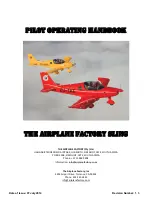
Pilot Operating Handbook
Cavalon Pro
SECTION 3
EMERGENCY PROCEDURES
RotorSport_POH_Cavalon Pro
Revision 1.0 – Issue 2 Date 16 03 2016
3-1
SECTION 3 - EMERGENCY PROCEDURES
This chapter contains the check lists and procedures to be executed in emergency
situations.
Emergencies due to defects of the gyroplane or its engine are extremely seldom if the
aircraft is checked thoroughly before each flight and continuously maintained. If there
should occur a case of emergency, the guidelines of this chapter are to be followed in order
to manage the emergency. However, these procedures do not replace the pilot’s
appreciation of the individual situation.
Strict compliance with the engine manufacturer’s maintenance schedules, operational
procedures and any additional instructions is essential. The aircraft must always be flown
with the risk of engine failure in mind, and flight over any areas where a forced landing
cannot be safely executed is at the pilots own risk.
3.1
Engine Failure
In case of an engine failure the following action is recommended:
Engine failure during take-off run
Maintain directional control using sensitive but appropriate pedal input
With the rotor/stick remaining aft, let gyroplane decelerate. Wheel brakes may be
used to assist
At walking speed level-off rotor disc, use wheel brakes and bring rotor to a stop
Engine failure after lift-off and below 150 ft AGL
The climb-out should be performed according to the Height-Velocity-Diagram
in CHAPTER 5
When engine failure occurs, and if height permits, immediately lower nose to enter
glide attitude and maintain airspeed.
Continue straight ahead.
Maintain airspeed until ground is approached, then perform flare.
If a low level engine failure, with low groundspeed, then an aggressive and immediate
flare may be required
Engine failure at or above 150 ft AGL
Consider wind speed and direction
Select a suitable landing site
If time allows, a restart may be attempted, see “Air restart procedure” below
Perform a landing into wind and/or upslope if possible
Prior to touch-down switch OFF Main Switch
Engine failure at night
Consider wind speed and direction
Both landing lights should be turned on at 400ft or below
Select a suitable landing site – the landing lights make the ground visible in full dark
from around 400ft
If time allows, a restart may be attempted, see “Air restart procedure” below
Perform a landing into wind and/or upslope if possible
















































